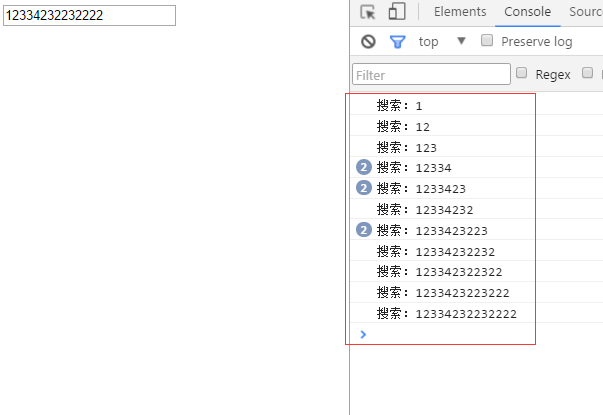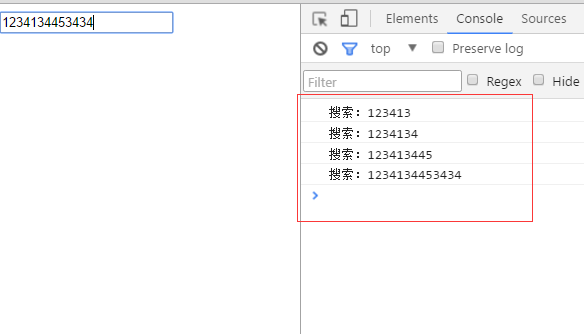Talk about function throttling in JS
The purpose of function throttling
It can be understood literally. Function throttling is used to throttle functions and optimize performance to a certain extent. For example, DOM operations are more efficient than non-DOM operations Interaction requires more memory and CPU time. Attempting to perform too many DOM-related operations in succession can cause the browser to hang and sometimes even crash. Especially using onresize in IE It is easy to happen when the event handler is used. When the browser is resized, the event will be triggered continuously. Inside the onresize event handler if you try to access the DOM operation, its high frequency of changes may crash the browser. For another example, for a common search function, we usually bind the keyup event and search every time the keyboard is pressed. But our purpose is mainly to search every time we enter some content. In order to solve these problems, you can use timers to throttle functions.
The principle of function throttling
Some codes cannot be executed continuously and repeatedly without interruption. The first time the function is called, a timer is created to run code after a specified interval. When the function is called a second time, it clears the previous timer and sets another one. If the previous timer has already been executed, this operation has no meaning. However, if the previous timer has not yet been executed, it is actually replaced with a new timer. The purpose is to execute the function only after the request to execute it has been stopped for some time.
Basic mode of function throttling
var processor = {
timeoutId: null,
//实际进行处理的方法
performProcessing: function(){
//实际执行的代码
},
//初始处理调用的方法
process: function(){
clearTimeout(this.timeoutId);
var that = this;
this.timeoutId = setTimeout(function(){
that.performProcessing();
}, 100);
}
};
//尝试开始执行
processor.process();Example scenario: Implementing common search functions
① Without using function throttling, bind the keyup event processing function to the input and output the content I input on the console.
Test main code:
<input id="search" type="text" name="search">
The result is as shown in the figure:

It can be seen that in this case, every time a keyboard key is pressed, it is output once. A short piece of content was output 14 times. If each time was an ajax query request, 14 requests would have been sent. The consumption in performance can be imagined.
②The case of using basic function throttling mode.
Test main code:
function queryData(text){
console.log("搜索:" + text);
}
var input = document.getElementById("search");
input.addEventListener("keyup", function(event){ queryData(this.value);
});
The results are as shown in the figure:
It can be seen that in this case, a lot of content was input and only output once, because the interval between two inputs was set to 500ms during the test. The actual application can be set according to the situation. Obviously, this has been greatly optimized in terms of performance. However, in this case, there is a new problem, as shown below:

Okay, maybe there is no clue. In fact, the problem is that if I keep typing and input a lot of content, but the interval between each two inputs is less than the delay value I set, then the queryData search function will never be called. In fact, what we prefer is that when a certain time value is reached, this search function must be executed once. Therefore, there is an improved model of function throttling.
③Function throttling enhanced version
Main code tested:
<input id="search" type="text" name="search">
function queryData(text){
console.log("搜索:" + text);
}
var input = document.getElementById("search");
input.addEventListener("keyup", function(event){
throttle(queryData, null, 500, this.value);
// queryData(this.value);
});
function throttle(fn,context,delay,text){
clearTimeout(fn.timeoutId);
fn.timeoutId = setTimeout(function(){
fn.call(context,text);
},delay);
}The test results are as shown in the figure:

Obviously, after continuous input, after a certain time interval, the queryData function will inevitably be called, but it is not called frequently. This achieves the purpose of saving money without affecting the user experience.
④Further optimization
If you go further, you can judge the input content before calling the throttle function. If the value is empty or the value remains unchanged, there is no need to call it again. I won’t go into details here.

Hot AI Tools

Undresser.AI Undress
AI-powered app for creating realistic nude photos

AI Clothes Remover
Online AI tool for removing clothes from photos.

Undress AI Tool
Undress images for free

Clothoff.io
AI clothes remover

Video Face Swap
Swap faces in any video effortlessly with our completely free AI face swap tool!

Hot Article

Hot Tools

Notepad++7.3.1
Easy-to-use and free code editor

SublimeText3 Chinese version
Chinese version, very easy to use

Zend Studio 13.0.1
Powerful PHP integrated development environment

Dreamweaver CS6
Visual web development tools

SublimeText3 Mac version
God-level code editing software (SublimeText3)

Hot Topics
 1666
1666
 14
14
 1425
1425
 52
52
 1327
1327
 25
25
 1273
1273
 29
29
 1252
1252
 24
24
 JavaScript Engines: Comparing Implementations
Apr 13, 2025 am 12:05 AM
JavaScript Engines: Comparing Implementations
Apr 13, 2025 am 12:05 AM
Different JavaScript engines have different effects when parsing and executing JavaScript code, because the implementation principles and optimization strategies of each engine differ. 1. Lexical analysis: convert source code into lexical unit. 2. Grammar analysis: Generate an abstract syntax tree. 3. Optimization and compilation: Generate machine code through the JIT compiler. 4. Execute: Run the machine code. V8 engine optimizes through instant compilation and hidden class, SpiderMonkey uses a type inference system, resulting in different performance performance on the same code.
 Python vs. JavaScript: The Learning Curve and Ease of Use
Apr 16, 2025 am 12:12 AM
Python vs. JavaScript: The Learning Curve and Ease of Use
Apr 16, 2025 am 12:12 AM
Python is more suitable for beginners, with a smooth learning curve and concise syntax; JavaScript is suitable for front-end development, with a steep learning curve and flexible syntax. 1. Python syntax is intuitive and suitable for data science and back-end development. 2. JavaScript is flexible and widely used in front-end and server-side programming.
 From C/C to JavaScript: How It All Works
Apr 14, 2025 am 12:05 AM
From C/C to JavaScript: How It All Works
Apr 14, 2025 am 12:05 AM
The shift from C/C to JavaScript requires adapting to dynamic typing, garbage collection and asynchronous programming. 1) C/C is a statically typed language that requires manual memory management, while JavaScript is dynamically typed and garbage collection is automatically processed. 2) C/C needs to be compiled into machine code, while JavaScript is an interpreted language. 3) JavaScript introduces concepts such as closures, prototype chains and Promise, which enhances flexibility and asynchronous programming capabilities.
 JavaScript and the Web: Core Functionality and Use Cases
Apr 18, 2025 am 12:19 AM
JavaScript and the Web: Core Functionality and Use Cases
Apr 18, 2025 am 12:19 AM
The main uses of JavaScript in web development include client interaction, form verification and asynchronous communication. 1) Dynamic content update and user interaction through DOM operations; 2) Client verification is carried out before the user submits data to improve the user experience; 3) Refreshless communication with the server is achieved through AJAX technology.
 JavaScript in Action: Real-World Examples and Projects
Apr 19, 2025 am 12:13 AM
JavaScript in Action: Real-World Examples and Projects
Apr 19, 2025 am 12:13 AM
JavaScript's application in the real world includes front-end and back-end development. 1) Display front-end applications by building a TODO list application, involving DOM operations and event processing. 2) Build RESTfulAPI through Node.js and Express to demonstrate back-end applications.
 Understanding the JavaScript Engine: Implementation Details
Apr 17, 2025 am 12:05 AM
Understanding the JavaScript Engine: Implementation Details
Apr 17, 2025 am 12:05 AM
Understanding how JavaScript engine works internally is important to developers because it helps write more efficient code and understand performance bottlenecks and optimization strategies. 1) The engine's workflow includes three stages: parsing, compiling and execution; 2) During the execution process, the engine will perform dynamic optimization, such as inline cache and hidden classes; 3) Best practices include avoiding global variables, optimizing loops, using const and lets, and avoiding excessive use of closures.
 Python vs. JavaScript: Community, Libraries, and Resources
Apr 15, 2025 am 12:16 AM
Python vs. JavaScript: Community, Libraries, and Resources
Apr 15, 2025 am 12:16 AM
Python and JavaScript have their own advantages and disadvantages in terms of community, libraries and resources. 1) The Python community is friendly and suitable for beginners, but the front-end development resources are not as rich as JavaScript. 2) Python is powerful in data science and machine learning libraries, while JavaScript is better in front-end development libraries and frameworks. 3) Both have rich learning resources, but Python is suitable for starting with official documents, while JavaScript is better with MDNWebDocs. The choice should be based on project needs and personal interests.
 Python vs. JavaScript: Development Environments and Tools
Apr 26, 2025 am 12:09 AM
Python vs. JavaScript: Development Environments and Tools
Apr 26, 2025 am 12:09 AM
Both Python and JavaScript's choices in development environments are important. 1) Python's development environment includes PyCharm, JupyterNotebook and Anaconda, which are suitable for data science and rapid prototyping. 2) The development environment of JavaScript includes Node.js, VSCode and Webpack, which are suitable for front-end and back-end development. Choosing the right tools according to project needs can improve development efficiency and project success rate.




